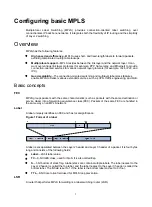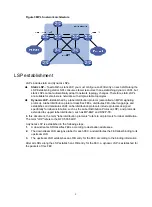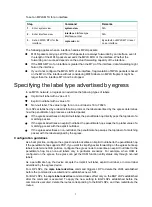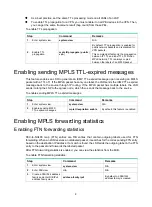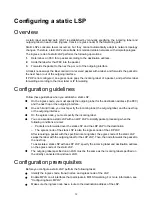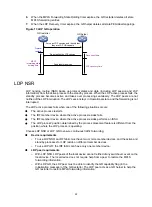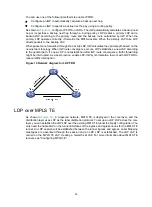
14
Figure 8 Network diagram
Configuration restrictions and guidelines
•
For an LSP, the outgoing label specified on an LSR must be identical with the incoming label
specified on the downstream LSR.
•
LSPs are unidirectional. You must configure an LSP for each direction of the data forwarding
path.
•
A route to the destination address of the LSP must be available on the ingress and egress
nodes, but it is not needed on transit nodes. Therefore, you do not need to configure a routing
protocol to ensure IP connectivity among all routers.
Configuration procedure
1.
Configure IP addresses and masks for all interfaces, including the loopback interfaces, as
shown in
. (Details not shown.)
2.
Configure a static route to the destination address of each LSP:
# On Router A, configure a static route to network 21.1.1.0/24.
<RouterA> system-view
[RouterA] ip route-static 21.1.1.0 24 10.1.1.2
# On Router C, configure a static route to network 11.1.1.0/24.
<RouterC> system-view
[RouterC] ip route-static 11.1.1.0 255.255.255.0 20.1.1.1
3.
Configure basic MPLS on the routers:
# Configure Router A.
[RouterA] mpls lsr-id 1.1.1.9
[RouterA] interface gigabitethernet 1/1/1
[RouterA-GigabitEthernet1/1/1] mpls enable
[RouterA-GigabitEthernet1/1/1] quit
# Configure Router B.
[RouterB] mpls lsr-id 2.2.2.9
[RouterB] interface gigabitethernet 1/1/1
[RouterB-GigabitEthernet1/1/1] mpls enable
[RouterB-GigabitEthernet1/1/1] quit
[RouterB] interface gigabitethernet 1/1/2
[RouterB-GigabitEthernet1/1/2] mpls enable
[RouterB-GigabitEthernet1/1/2] quit
# Configure Router C.


